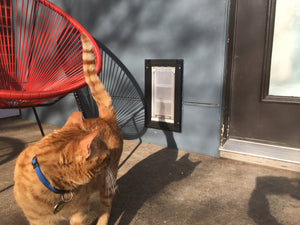What Are Tapeworms in Cats?
Tapeworms are intestinal parasites that can live in cats and dogs and reach up to 11” in length. There are a few types of tapeworms that can infect pets, the most common being Dipylidium caninum.

How Do Cats Get Tapeworms?
Tapeworms are transmitted to cats through fleas. A tapeworm egg must be ingested by a flea larva, in which the tapeworm egg continues to develop as the flea grows into adulthood.
If a cat accidentally swallows the flea, they’ve also ingested the tapeworm egg. When the tapeworm egg is released into the cat’s digestive system, it anchors itself to the intestinal lining with its hook-like mouth. This completes the lifecycle of the tapeworm.
Can Cats Get Tapeworms from Eating Tapeworm Eggs?
Unlike other intestinal parasites, cats will not become infected with tapeworms by ingesting their eggs. Tapeworm eggs must be ingested by a flea before infecting a cat. The flea is the intermediate host and cats are the final hosts for the tapeworm.
What Are the Signs of Tapeworms in Cats?
The most common way you can detect tapeworms in your cat is by examining their feces. Segments of tapeworm can break off and pass through the cat’s stool or vomit and can be seen crawling on the surface. The tapeworm segments will look like grains of cooked white rice or cucumber seeds.
Physical symptoms of tapeworm may vary between cats, but there are a few symptoms you can look out for if you suspect your cat has tapeworms:
- Seizures
- Unpredictable appetite
- Irritability
- Mild diarrhea
- Intestinal blockages
- Shaggy coat
- Weight loss
Not all cats will present symptoms when they have tapeworms, and it’s important to note that routine fecal exams will not identify tapeworms unless there happened to be segments of the parasite in the sample.
If a tapeworm goes untreated, it can lead to vomiting, diarrhea, weight loss, and poor appetite. These symptoms can put your cat at risk if they start losing weight rapidly. Tapeworms can live up to two years in cats.
Sometimes they will not cause great harm to their host, but kittens and older cats are particularly susceptible to adverse effects of tapeworms. It’s important to keep an eye out for signs of tapeworm to pursue the proper diagnosis and treatment from your vet.
How is Tapeworm in Cats Treated?
Luckily, there is a cure for tapeworms in cats. If your vet examines your cat’s fecal sample and identifies tapeworms, they will prescribe deworming medications like epsiprantel, praziquantel, and fenbendazole. If not already treating your cat for fleas, you’ll need to do that as well.
Whether you have an indoor cat or an outdoor cat, you will also need to treat your home and other pets for fleas to eradicate any remaining tapeworm hosts that could re-infect your pets. The best way to prevent tapeworms in cats is to give them a monthly flea treatment to reduce the risk that your cat will ingest a flea while grooming.
Interested in learning more about cats? Check out these 8 human food cats can eat too.




